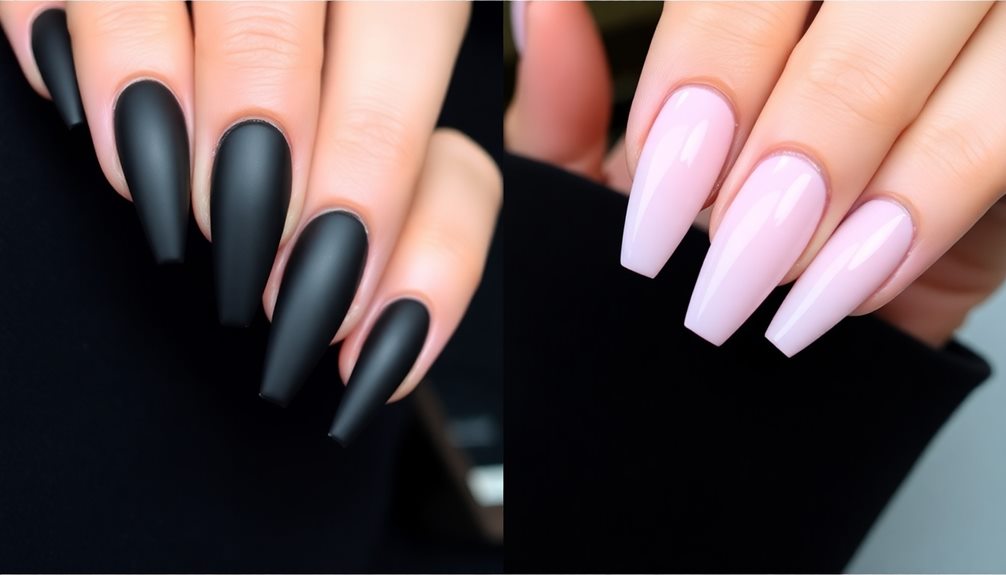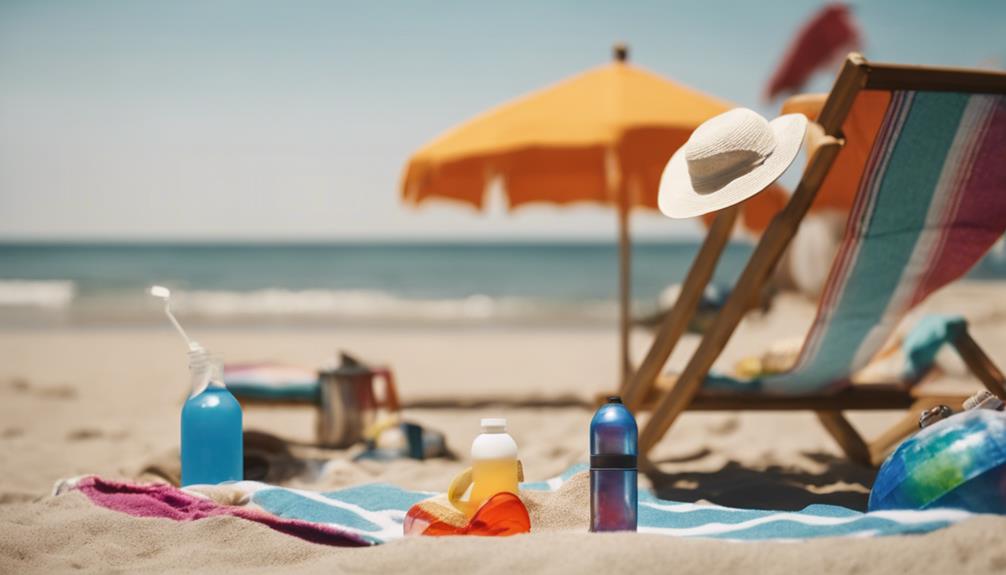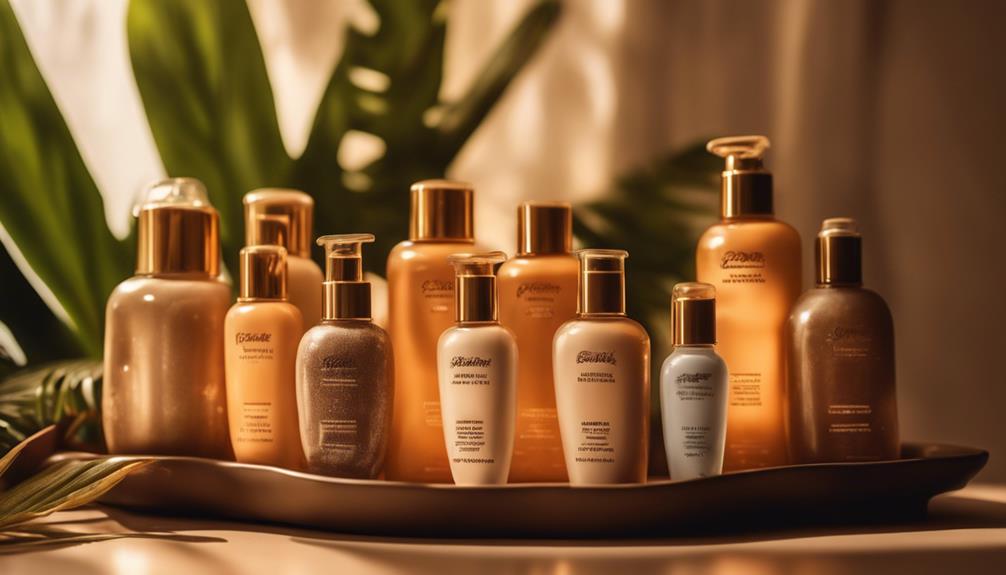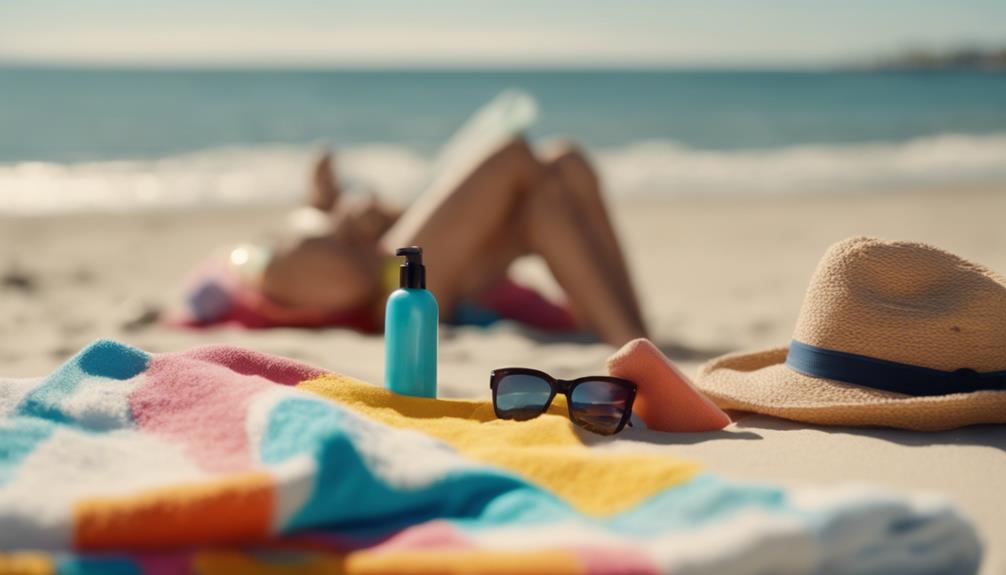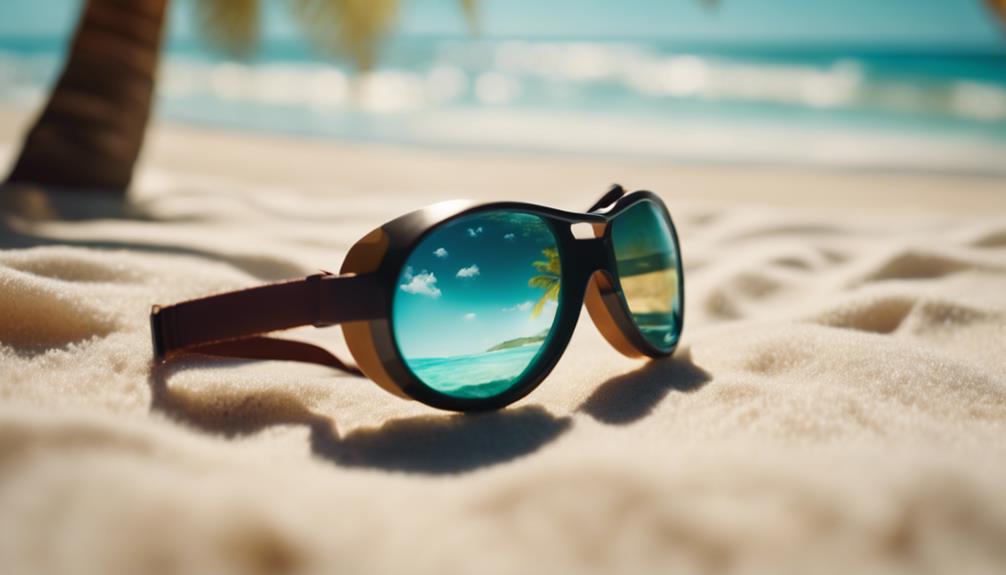To protect your hair from sun, salt, and sand, start with pre-swim care by soaking it in fresh water and using protective hairstyles like braids or buns. Always rinse with fresh water right after beach activities to remove salt and sand. Apply a hydrating conditioner to restore moisture, and consider using UV protection sprays to prevent sun damage. Avoid harsh treatments before your beach trip and limit heat styling. Regularly incorporating deep conditioning masks can help maintain hair health. For more tips on keeping your locks beautiful in beach conditions, keep exploring this care guide.
Key Takeaways
- Pre-soak hair in freshwater before swimming to reduce salt absorption and maintain moisture levels.
- Use protective hairstyles like braids or buns to minimize tangling and secure hair during beach activities.
- Rinse hair immediately after beach exposure to remove salt, sand, and chlorine, and apply a nourishing conditioner.
- Incorporate UV protection sprays or leave-in conditioners to shield hair from sun damage and retain moisture.
- Regularly use deep conditioning treatments to combat dryness and maintain hair health post-beach outings.
Benefits and Risks of Ocean Water
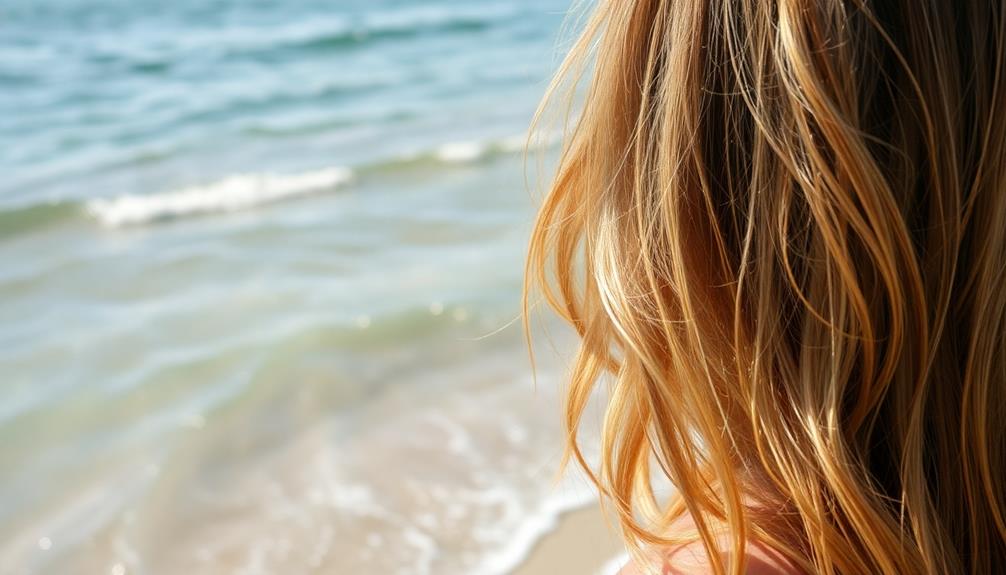
When you hit the beach, you mightn't realize that ocean water can be both a blessing and a curse for your hair. The benefits of ocean water include its rich vitamins and minerals, which can nourish your scalp and promote hair growth when you're only exposed for short periods.
Additionally, certain herbal teas, like chamomile, may help soothe any irritation caused by sun exposure, enhancing your overall beach experience while keeping your scalp healthy Herbal tea benefits.
However, the risks of prolonged salt exposure can lead to hair dehydration, stripping moisture from your strands and making them dry and brittle.
To balance these benefits and risks, it's essential to take some precautions. Before diving in, rinse your hair thoroughly with fresh water. This simple step can greatly reduce salt absorption and minimize potential damage.
While some people love how saltwater can enhance texture, it can also cause frizz and tangling, especially for curly or fine hair.
After your swim, don't forget about post-swim care. Use a hydrating conditioner or leave-in treatment to replenish lost moisture and restore your hair's health.
Preparing Hair for Ocean Activities

Before you hit the waves, pre-soaking your hair in freshwater can really help reduce salt absorption and protect it from dehydration.
Additionally, consider sipping on a cup of herbal tea to keep yourself hydrated from the inside out and enhance the health of your hair.
It's also smart to choose protective hairstyles like ponytails or braids to keep your locks tangle-free and shielded from sand and wind.
Pre-Soaking Hair Benefits
How can you best protect your hair during a day at the beach? One effective method is pre-soaking your hair in freshwater before diving into the ocean. This simple step notably reduces salt absorption, minimizing the risk of dehydration and damage.
Wet hair is less absorbent than dry hair, which helps it retain moisture and prevents brittleness caused by prolonged exposure to saltwater. Additionally, maintaining hydration is essential, just like how regular maintenance of an air purifier can enhance performance and efficiency air purifier maintenance dos and don'ts.
For added protection, consider using a leave-in conditioner or hair oil during your pre-soaking routine. These products create a moisture barrier, further shielding your hair from the drying effects of saltwater.
Plus, pre-soaking contributes to tangle-free hair, making it easier to manage and style while you're enjoying ocean activities.
Incorporating pre-soaking into your beach routine not only enhances hydration but also boosts your hair health, fortifying it against the damaging effects of sun, salt, and sand.
Recommended Protective Hairstyles
Choosing the right protective hairstyle can make all the difference during your beach day. Not only do protective hairstyles help reduce breakage, but they also keep your hair secure and manageable amidst sun, salt, and sand.
Additionally, just as ride-on car toys enhance motor skills, protective hairstyles can aid in maintaining your hair's health and well-being during outdoor activities. Here are some great options to contemplate:
- Braids: These minimize tangling and can withstand ocean activities.
- Buns: A classic option that keeps your hair off your neck and face.
- Twisted or rope ponytails: Ideal for fine hair, these styles help prevent knots while providing security.
- Headbands or buffs: Use these to keep hair away from your face and protect your scalp from sun exposure.
- Pre-soaking hair: Don't forget to pre-soak your hair in freshwater to maintain moisture levels before you tie your hair up!
Regularly brushing your hair before heading into the waves, along with using detangling sprays afterward, will help maintain smoothness and reduce the risk of damage.
Choosing the Right Hairstyle

Finding the right hairstyle for a day at the beach can enhance both your comfort and your look. To make the most of your beach day, consider secure hairstyles like buns, braids, or ponytails. These styles help minimize damage and tangles caused by wind and water activities.
For curly hair, tighter styles work best to prevent frizz while you swim, creating a protective barrier against salt and UV damage.
Before you hit the waves, always brush your hair to reduce knots and tangles. Applying a leave-in conditioner can boost protection and moisture retention, keeping your hair healthier in harsh conditions. You might also want to use hair ties that are gentle on your strands to avoid breakage.
Additionally, headbands or buffs can help keep hair away from your face, reducing exposure to saltwater and sand. This simple step can further prevent dryness and breakage.
Experiment with different styles to find what works best for your hair type; for instance, braids are excellent for coarse hair, while twisted ponytails are ideal for fine hair.
With the right hairstyle, you can enjoy the beach while keeping your hair looking fabulous!
Essential Hair Accessories

Accessorizing your beach hair can greatly enhance its protection and style. By incorporating essential hair accessories into your beach hair care routine, you can shield your locks from damaging beach elements while keeping them chic.
It’s also important to reflect on how sun exposure can affect your hair health, just as it affects your skin; proper tanning methods can help you understand the impact of UV rays. When spending time in the sun, it’s essential to protect your hair from damage by using the right products. That’s where top tanning lotions come in; these specially formulated lotions not only protect your skin, but also provide added moisture and protection for your hair. By using top tanning lotions, you can enjoy the sun without compromising your hair health.
Here are some must-have items to reflect on:
- Neoprene mask straps: These help reduce hair breakage during plunging and provide a secure fit.
- Silicone hair ties: With their non-slip feature, they keep your hairstyle intact and minimize damage.
- Spiral hair ties: These are ideal for delicate hair types, as they minimize breakage compared to standard ties.
- Headbands: Perfect for managing flyaways, headbands keep hair away from your face and maintain a neat appearance.
- Buffs: These versatile accessories can be worn in various styles, offering both protection and flair.
Experimenting with these accessories can help you find what works best for your hair type and activity level.
By prioritizing hair protection with the right tools, you can enjoy your beach day without worrying about the impact of sun, salt, and sand on your hair.
Post-Activity Hair Care
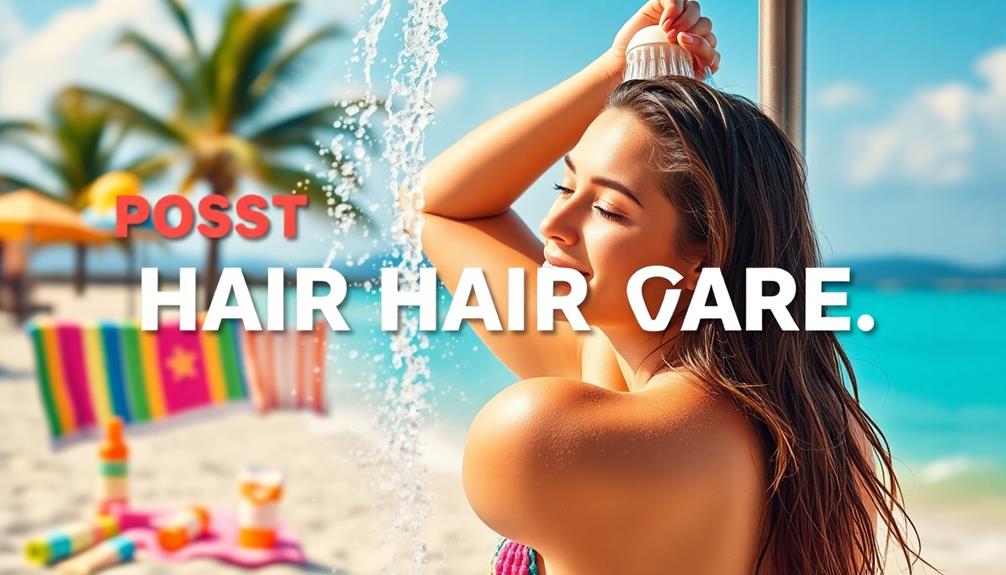
After your beach activities, rinsing your hair with fresh water is vital to wash away salt, sand, and chlorine that can dry it out.
Additionally, protecting your hair from sun exposure is important, as UV rays can cause significant damage and dryness, much like skin.
Once you've rinsed, applying a nourishing conditioner will help replenish the moisture your hair lost in the sun and surf.
Don't forget to take into account a leave-in treatment for extra hydration and protection moving forward.
Protecting your hair from sun damage is essential for maintaining its health.
Immediate Rinsing Importance
Rinsing your hair immediately after beach activities is essential for maintaining its health and vibrancy. The exposure to salt water, sand, and UV rays can wreak havoc on your hair if you don't act quickly. Aim to rinse within 30 minutes to minimize damage and dehydration, especially since improved air quality can also impact your hair's resilience against environmental stressors air quality benefits.
- Removes salt and sand residue
- Reduces brittleness caused by environmental stressors
- Helps maintain moisture balance
- Protects against UV damage
- Prepares your hair for conditioning treatments
Using fresh water to rinse off will help wash away harmful particles, while a gentle clarifying shampoo can effectively cleanse your hair without stripping its natural moisture.
After rinsing, apply a hydrating conditioner or leave-in treatment to replenish lost moisture, promoting shine and softness. These steps are essential for sustaining hair health, keeping it strong and vibrant.
Nourishing Conditioner Application
Your hair deserves some extra love after a day at the beach, and applying a nourishing conditioner is an essential step in post-activity care. Start by rinsing your hair with fresh water to remove salt, sand, and chlorine, which can lead to dehydration and damaged hair.
Proper hair care is important to maintain its health during summer activities. Once your hair is clean, apply a nourishing conditioner or hair mask specifically formulated for dry or damaged hair. Look for ingredients like aloe vera and glycerin to replenish moisture lost during sun and salt exposure.
For best results, allow the conditioner to sit in your hair for several minutes. This deep conditioning process lets the product penetrate your strands, revitalizing them and promoting softness and shine.
After rinsing, consider using a leave-in conditioner. This additional layer provides ongoing hydration and protection against future environmental stressors, ensuring your hair stays healthy and manageable.
Moisturizing Treatment Options
Maintaining moisture in your hair after a day at the beach is essential for its health and appearance. The sun, salt, and sand can wreak havoc on your locks, so it's important to take immediate action.
Start by rinsing your hair with fresh water to remove any salt and sand, which helps prevent dehydration. Additionally, incorporating proper storage of hair products can further enhance the moisture retention and effectiveness of your treatments.
Here are some effective moisturizing treatment options to keep in mind:
- Hydrating conditioner: Replenish moisture lost during sun exposure.
- Moisturizing hair mask: A deep treatment that helps restore softness and shine.
- Leave-in conditioners: Provides ongoing hydration and protection against future damage.
- Regenerating mask: Use weekly to revitalize and combat saltwater dryness.
- Gentle drying techniques: Opt for air drying or a microfiber towel to reduce breakage.
Incorporating these treatments into your routine will help reduce dryness, prevent sun damage, and nourish your hair.
Sun Protection for Hair

The sun can wreak havoc on your hair, causing brittleness and fading color if you don't take precautions. To maintain the health and vibrancy of your locks during beach adventures, sun protection is essential. Here are some effective hair care tips to take into account:
| Product Type | Benefits | Application Tips |
|---|---|---|
| UV Protection Spray | Shields against UV rays | Apply generously before sun exposure |
| Moisturizing Cream | Preserves moisture | Use daily to nourish hair |
| Leave-In Conditioner | Prevents color fading | Apply after washing for added protection |
| Hair Oil | Adds shine and hydration | Use sparingly on ends |
Invest in hair products like SU Milk that contain UV filters to guarantee your hair stays light, soft, and hydrated. These products help preserve moisture and prevent color fading, allowing you to enjoy your beach days worry-free. Plus, many retailers offer discounts during promotional sales, making it easier to stock up on these essentials. Don't forget, regular use of UV protectant hair products markedly enhances the longevity of your hair color and overall hydration levels!
Common Mistakes to Avoid
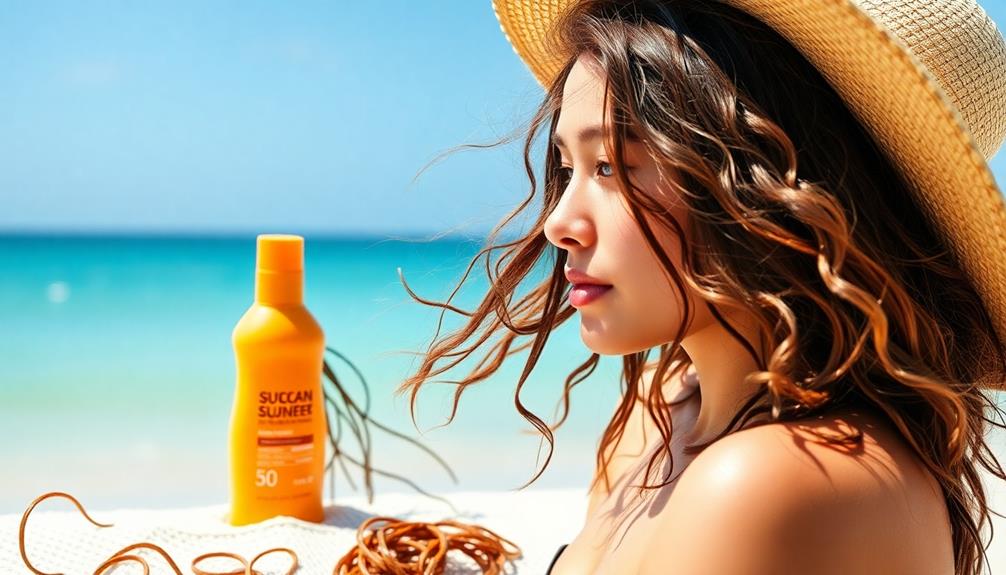
Even with proper sun protection, it's easy to overlook some common mistakes that can compromise your hair's health during beach outings. To guarantee your locks stay vibrant and strong, steer clear of these pitfalls: Consider using best beach wave sprays to help maintain your hair's texture while protecting it from the elements.
- Avoid aggressive treatments before your beach day; coloring or chemical straightening can weaken your hair.
- Use protective styles like braids or buns to keep long hair secure and prevent tangling and sunburn on your scalp.
- Skip loose hairstyles; they're more prone to wind damage and can lead to breakage. Opt for tight ponytails or braids instead.
- Limit heat styling tools during the summer months. The excess heat can exacerbate the drying effects of sun exposure and saltwater.
- Embrace your natural texture; trying to maintain winter styles can lead to more damage when your hair is wet or exposed to harsh beach conditions.
After-Beach Hair Care Routine

After a day at the beach, rinsing your hair immediately is essential to remove salt, sand, and debris that can lead to damage and dryness.
Start by rinsing your hair thoroughly with fresh water. Next, use a gentle shampoo, like H.A.P.I. Shampoo, to cleanse without stripping moisture. This helps maintain your hair's natural oils while effectively removing any residual salt.
After shampooing, follow up with a hydrating conditioner to replenish lost hydration. This step is vital for restoring moisture and preventing dryness.
Once you've rinsed out the conditioner, apply a leave-in treatment to provide added hydration and protection against future damage from sun exposure and environmental factors.
To boost your hair's health, make it a habit to regularly use a deep conditioning mask, such as the SU Hair Mask, after beach days. This will help restore softness and shine, counteracting any harsh effects from the sun and sea.
Additionally, schedule trims every 6 to 12 weeks to eliminate split ends and maintain overall hair health, ensuring your locks remain resilient against beach elements.
Long-Term Hair Care Strategies
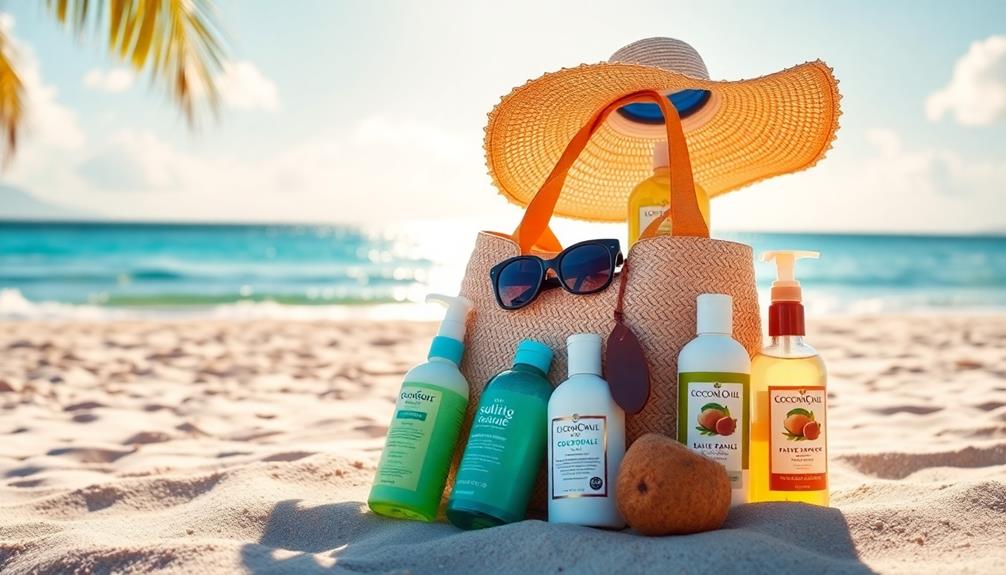
Maintaining vibrant, healthy hair long-term requires a commitment to hydration and nourishment. The sun and salt can wreak havoc on your hair, but with the right strategies, you can guarantee your locks remain strong and resilient.
Here are some key practices to keep in mind:
- Use moisturizing products like leave-in conditioners and masks regularly.
- Incorporate a balanced diet rich in vitamins, especially biotin, zinc, and omega-3 fatty acids.
- Commit to regular scalp care, including exfoliating treatments, to foster a healthy environment for hair growth.
- Limit the use of heat styling tools, particularly during summer, to avoid cumulative damage.
- Consider professional treatments, such as keratin or bonding, for added strength against environmental stressors.
Frequently Asked Questions
How Can I Protect My Hair From Sun and Saltwater?
To protect your hair from sun and saltwater, pre-soak it in freshwater, apply a leave-in conditioner, use SPF-infused products, rinse after swimming, and consider protective hairstyles to minimize damage and tangling.
How to Keep Sand Out of Your Hair at the Beach?
Think of sand as a mischievous child, enthusiastic to invade your hair. To keep it at bay, wear a hat, tie your hair up, and apply a leave-in conditioner for extra protection. Enjoy your beach day!
How to Protect Your Hair When Going to the Beach?
To protect your hair at the beach, pre-soak it with fresh water, use UV-protectant products, style it in braids or ponytails, and rinse immediately after swimming to prevent damage from salt and sand.
Is Salt Water and Sun Good for Hair?
You might think saltwater and sun are great for your hair, but they can actually cause damage if you're not careful. Brief exposure can nourish, yet prolonged contact leads to brittleness and fading. Be cautious!
Conclusion
With the sun setting like a fiery ball on the horizon, remember that caring for your hair is just as important as enjoying your beach day. By taking simple steps to protect your locks from the harsh sun, salt, and sand, you can keep your hair looking vibrant and healthy. Embrace these tips, and your hair will shine like the sun, even after a day by the waves. Don't let the beach leave you with a tangled mess—your hair deserves better!

